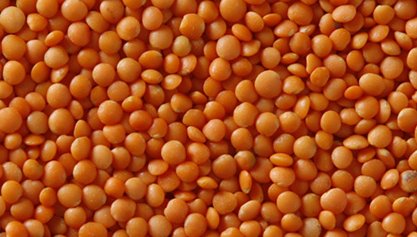Many recipes call for the inclusion of red lentils in the ingredients list but most of us are not clear exactly what they are and where they originate. Where do they come from, how should they best be cooked, what are their nutritional value, what is their storage life? This article will answer those and many other questions about red lentils n simple and clear to understand language.
All lentils (lens culinaris) are part of the legume family of plants as are peanuts and peas. A lentil plant typically grows to 40cm high and when mature will have produced many pods which contain lentil seeds. These seeds (roughly two per pod) are what we eat as lentils.
The vast majority of the world's lentil production is in Canada and Australia. Annual production of lentils amounts to over 6 million metric tons. Typically the seeds are sown in May and harvested around August time.
There are several different types of lentils, the most common being the brown and green lentils. The only "brown" part of a brown lentil is the pod skin. If you remove that skin, the lentils are red on the inside.
Now you know that red lentils are, simply brown or green lentils with their skins removed.
When lentils are harvested they are processed by a variety of machines. Firstly the chaff and any stones or earth are removed to clean up the lentils. Then there is a machine which removes the outer skin leaving only red lentils.
At this stage, the lentils are called "football lentils" because of their more round shape compared to when they are split.

Football Red Lentils
Nothing is wasted in this process, the skins of the lentils are used as animal feed.
Occasionally these football lentils are left in that shape but the vast majority are split to become the split red lentils most of us are familiar with. Primarily they are split because that permits a very quick cooking time. The splitting process is performed by specialist machines.
Unless a recipe specifies football red lentils, you can be sure that an ingredient name of red lentils is referring to split red lentils.
The next process involves a machine which cleans up the split lentils followed by another machine which sorts the split lentils into various sizes. Finally they are packed and sold to the consumer.
Split red lentils are typically used when you want them to cook down to a puree, they are ideal for thickening soups, curries and stews. Split red lentils are also one of the key ingredients for the famous Indian dish, dahl. Before cooking, rinse the lentils in water to wash off any residue,
Red lentils can be cooked in any liquid, water or coconut milk are frequently used. Add the lentils to the liquid used in the recipe, bring to a boil and simmer for 15 minutes or so. After this time the red lentils will have turned to a puree.
The picture above is of Ham and Red Lentil Soup, the recipe for this delicious meal can be found by clicking here.
Red lentils are an extremely cheap and tasty source of a wide variety of nutrients. The basic information for a 100g serving of split red lentils are:
Calories 115
Carbohydrates 17.9g
Protein 8.9g
Fat 0.4g
Fibre
5.1g
3.5mg iron
40mcg selenium
30mcg folate
All packs of split red lentils sold in the UK will a "Best Before" date on them. This dae refers the pack when unopened. As soon as the pack is opened the contents should be stored in an airtight container in dry conditions. If this is done the best before date can be adhered to.
However, the best before date does not mean that the product is unsafe to eat after that date. It just indicates that past this date the product will not be at its best.
With red lentils, if they are stored and then cooked correctly, they should be safe well beyond the "best before" date. However their nutrient levels will reduce over time. They will also gradually harden over their surface making it difficult to tenderise them.